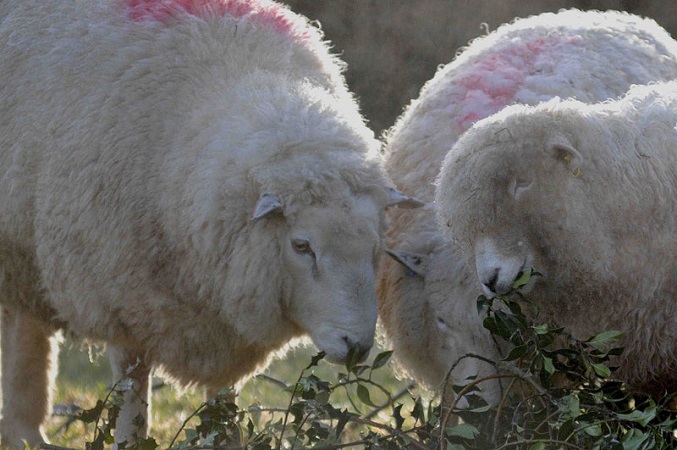

Algae
Blue-green algae, which is most often found in stagnant, slow-moving water when temperatures are high, can poison sheep. Symptoms generally develop quite rapidly and may resemble an allergic reaction. Convulsions may occur, but more frequently the sheep sinks to the ground and dies without struggling. Smaller amounts of poison cause weakness and staggering, followed by recovery. In some instances, apparent recovery from an attack is followed in a few days or weeks by evidence of photosensitization. There may be inflammation of the muzzle, the skin of the ear, the udder, or other parts of the body. Jaundice is often seen, and constipation is a common symptom. Such cases usually recover under good care.
Copper
Copper toxicity is especially dangerous in sheep because their liver accumulates copper much more readily than in other animals. Although copper is essential for sheep, too much copper can cause anemia, lack of appetite, fragile bones, lethargy, teeth grinding, jaundice, bloody urine, hair loss, and poor wool coverage. Sheep are ten times more susceptible to this condition than goats. Copper can accumulate in a sheep’s liver for a up to a year without any symptoms until the liver releases a large amount at once, causing damage to their red blood cells. Copper toxicity can also be a result of a lack of dietary molybdenum, sulfur, zinc, calcium, or liver damage. Left untreated, copper toxicity can be fatal in only a few days after presenting symptoms. If you suspect copper toxicity in sheep, contact a veterinarian immediately. Veterinary treatment includes a daily drench of ammonium molybdate and sodium sulfate in specific quantities (too much can cause serious health repercussions). The best prevention includes ensuring that the sheep are not eating too much copper in their diet.
Grain Overload (Acidosis, Grain Poisoning)
Grain overload occurs when sheep eat large amounts of grain, causing carbohydrates to be released in the rumen and ferment instead of being normally digested. Lactic acid is produced resulting in slowing of the gut, dehydration and sometimes death. While wheat and barley are the most common causes of grain overload, lupins and oats can also be the culprit.
Grain overload is most commonly seen where sheep may be in a newly harvested pasture and spilled and unharvested grains remain, and when sheep gain access to bags or cans of grains and pellets. If a sheep isn’t accustomed to eating grain, a sudden switch to grains can cause grain overload as well.
Signs of grain overload include: depressed appearance, lying down, diarrhea, dehydration and thirst, bloating (of the left side of the abdomen), staggery or tender gait and ‘sawhorse’ stance and death.
If you suspect a sheep has grain overload, contact your veterinarian immediately. Treatment depends on the severity of the condition. Following grain overload, the rumen lining takes up to six weeks to repair, and some animals may develop secondary infections that will require veterinary treatment.
Hardware Disease
Hardware Disease refers to the injuries that can result from any animal resident eating something they shouldn’t, especially pieces of human-made hardware like nails, screws, and staples. Hardware disease can have devastating effects on any resident.
Lead Toxicity
Lead was once used in paints and pesticides, and can also be found from natural environmental sources. Even if you have never used any products containing lead, it may still be present in old barn or fence paint, or in the soil. Places where old machinery and leaded gas have been stored may also have caused contamination, as would old treated lumber and railroad ties. Sheep may ingest the lead in the environment through the consumption of grass, clover, and dandelion or from chewing or licking on tainted surfaces.
 Contact Jaguza Support
Contact Jaguza Support